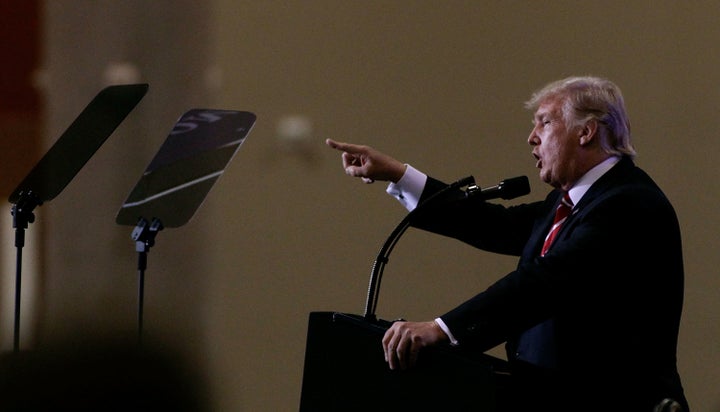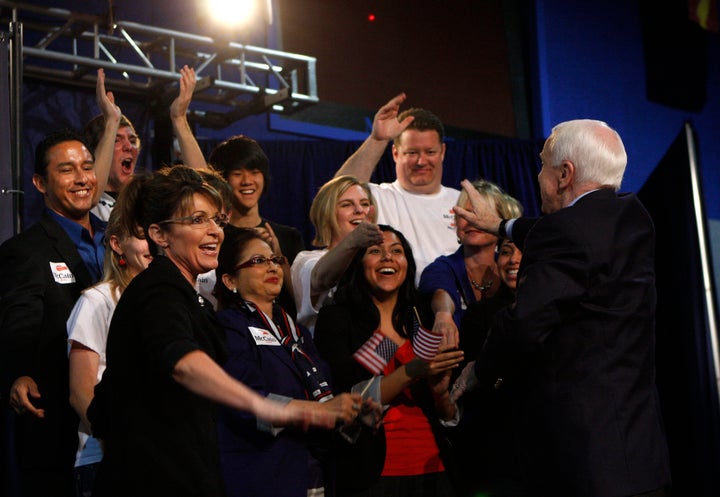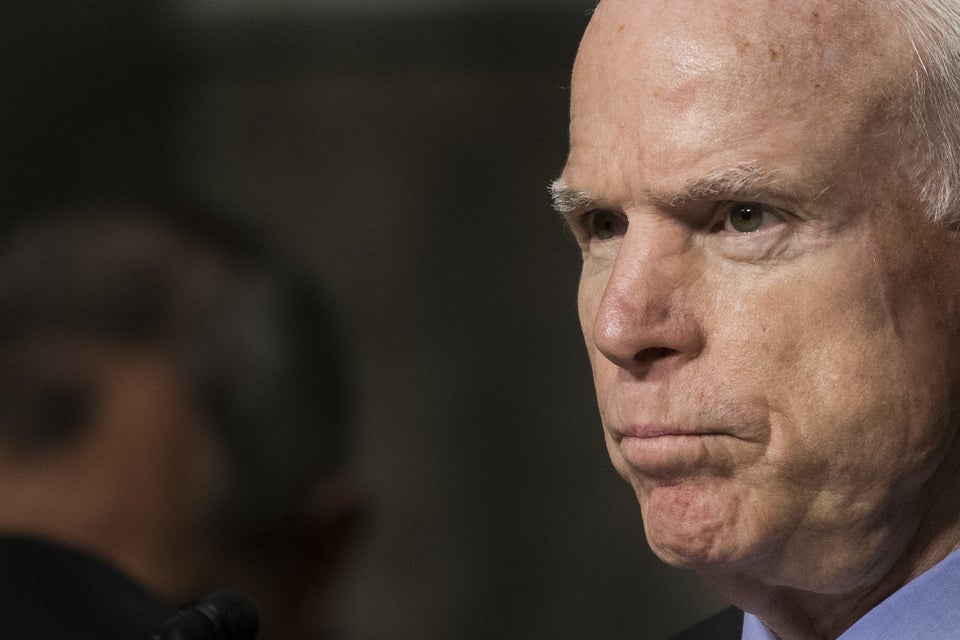
WASHINGTON ― Once upon a time, Republicans decided they needed to attract Latinos and Asians and blacks. They created a special committee to figure out why it wasn’t happening and to find ways to fix it. The very future of the party was at stake.
All of that, of course, took place circa 3 BT ― Before Trump.
Now the party’s leader uses the White House bully pulpit to equate neo-Nazis and defenders of Confederate monuments with those who protest them. He is expected Tuesday to announce an end to his predecessor’s policy not to deport people brought into this country unlawfully as children. He has even pardoned a former sheriff convicted of contempt of court for illegally rounding up suspected undocumented immigrants.
“I think it will catch up to them and be disastrous,” said political consultant Stuart Stevens of his fellow Republicans who continue to support Donald Trump. “I don’t think the 2016 election repealed demographics…. It’s like someone who goes to a party and has a few too many drinks and makes it home all right and decides that alcohol makes you drive better. I’m not sure that’s the right conclusion.”
Stevens in 2012 was a top aide to Mitt Romney, whose loss to Democratic President Barack Obama was caused in part by winning only 27 percent of the Latino vote sparked the Republican National Committee’s “Growth and Opportunity Project” report the following spring.
It was dire in its tone, laying out long-term consequences if the party did not improve its relationship with minority communities. “The nation’s demographic changes add to the urgency of recognizing how precarious our position has become,” the so-called autopsy stated. “According to the Pew Hispanic Center, in 2050, whites will be 47 percent of the country while Hispanics will grow to 29 percent and Asians to 9 percent.”
Notwithstanding all of that, Trump won the White House while seeming to do and say exactly the opposite of what the report had recommended. The result: a party whose long-term future may be even more bleak now.
“He’s branding the party as so toxic to so many people,” said Ruy Teixeira, a demographer at the liberal Center for American Progress. “The Democrats are in a better position in terms of how the country is changing than the Republicans are.”
Ari Fleischer, a press secretary to former President George W. Bush and an author of the 2013 autopsy, said Trump was able to win the election by bringing out more white voters, which does not appear to be a sound long-term strategy.
“The demographic trend is continuing,” Fleisher said. “Trump may have changed the math, but only temporarily.”
The White Base
Trump’s strategy of playing to the white voting base is not new. While Republicans were instrumental in the 1950s and early 1960s in the passage of legislation helping African-Americans, including the landmark 1964 Civil Rights Act, Richard Nixon took the opposite tack in his 1968 presidential campaign.
He played to white resentment of that law, euphemistically calling for “law and order” to let voters, particularly whites in the South, know that he did not support activists clamoring to end segregationist policies.
That “Southern Strategy” was detailed in Nixon aide Kevin Phillips’ 1969 book, The Emerging Republican Majority, which correctly predicted a sustained period of GOP dominance.
While most Republican candidates denied there was any such race-based effort underway, that claim was later undercut by top party strategists. In 1991, infamous political operative Lee Atwater, as he was dying of a brain tumor, apologized for his party’s tactics through the years, and in 2005, GOP chairman Ken Mehlman apologized for the party’s reliance on racial polarization. “I am here today as the Republican chairman to tell you we were wrong,” he told the annual meeting of the NAACP.
Despite the official repudiation, though, some Republican candidates continued their targeted appeals to white voters, particularly white voters without a college education. In 2008, while John McCain’s vice presidential running mate, Sarah Palin regularly attacked Obama, the first black major-party nominee, as somehow un-American.

And in 2012, in his efforts to win over an increasingly anti-immigration primary voting base, Romney said his policies would be so harsh that people in this country illegally would probably “self-deport.”
That tone, combined with Obama’s popularity with Latinos, ended with Romney winning just 27 percent of the Latino vote. McCain had won 31 percent in 2008, and George W. Bush, running for re-election, had won 40 percent in 2004.
The party’s post-election autopsy cited Romney’s performance in its analysis about what to do next. “If we want ethnic minority voters to support Republicans, we have to engage them and show our sincerity,” the report stated. “If Hispanics think we do not want them here, they will close their ears to our policies.”
At the party’s summer meeting in Boston that August, then-chairman Reince Priebus – who later went on to help Trump win the presidency and served as his first chief of staff ― went even further. “Using the word ‘self-deportation’ ― I mean, it’s a horrific comment to make,” Priebus said back in 2013. “It’s not something that has anything to do with our party. But when a candidate makes those comments, obviously it hurts us.”
The party began that year to reverse things. They hired staff in key states to build a Republican presence in Latino communities long before the next election to show that they were serious about long-term relationships, not just a frantic get-out-the-vote push at the very end. That appeared to pay off in the 2014 midterms. In Colorado, Republican Senate nominee Cory Gardner ran nearly even in heavily Latino Pueblo County, for example, helping him squeak out a narrow 2.5-percentage-point victory over incumbent Democrat Mark Udall.
Party leaders saw that as proof that their approach could work, and they set out to replicate it for the general election.
And then Trump rode down his Manhattan escalator and accused undocumented immigrants of being rapists and drug dealers ― essentially setting the tone for the whole of his campaign, the first seven months of his presidency and the party he now leads.
“There’s not a Republican Party,” said one prominent GOP strategist who spoke on condition of anonymity. “There’s a Trump party. It’s an uncompassionate conservatism. And it’s not even conservatism.”
Playing To Fears
Whether the Trump message is “conservative” or not, it is appealing to ― and perhaps designed for ― a segment of the Republican voting base that sees the increasing percentage of African-Americans, Asians and particularly Latinos as not merely a problem for the country but the major one.
From the middle-aged white men at the 2015 Iowa State Fair discussing how illegal immigrants had to be stopped because their children born in the United States are U.S. citizens to the Florida woman who supported Trump because she just preferred being around white people to the grandmother waiting to enter a Trump rally in northeast Ohio last year who believed that immigrants speaking in a foreign language near her were ridiculing her, many of Trump’s supporters saw him as their best hope of regaining the American culture of the 1950s or early 1960s.
““They should speak English in public. It’s fine if they want to speak in their own language at home,” said Brenda Johnson after driving four hours from Cincinnati to see Trump in person.
It is that sentiment, Trump critics say, that he is actively stoking by repeatedly referring to “our culture” in his public statements about the neo-Nazi rally and ensuing violence in Charlottesville, Virginia, earlier this month.
“Sad to see the history and culture of our great country being ripped apart with the removal of our beautiful statues and monuments,” Trump wrote on Twitter about memorials to Confederate leaders. “They’re trying to take away our culture. They’re trying to take away our history,” he told thousands of rally-goers in Phoenix last week.
The “culture” and “history” in question is that of the pro-slavery South and its leaders who took up arms against the United States, resulting in what remains the deadliest war in the nation’s history ― a clear message to white voters who harbor racial resentments that Trump is on their side, his critics believe.
Even his slogan, “Make America Great Again,” they add, has little appeal to minorities whose lives are markedly better than they were several decades ago, while sending a clear message to white voters aggrieved by the status they believe they have lost in those years.
But while resonating with a chunk of Republicans voters, Trump’s language is hardening negative views against him in just about everyone else, the Center for American Progress’ Teixeira said.
“Thoughtful Republicans are a little bit nervous,” Teixeira said, but he added that it is difficult for them to do anything to thwart their own president.
He said the fact that less than 80,000 votes in three states provided Trump’s margin of victory despite the weakness of his opponent and the help of a foreign power should be setting off alarm bells. He pointed to smaller victory margins in traditionally Republican states with high minority populations, including Georgia, Arizona and Texas, as evidence that continued alienation of non-white voters could easily backfire.
“That’s the handwriting on the wall. That’s sending a signal about what’s going on in those states,” Teixeira said. “But until people see that it hurts them, until they get hit upside the head with a two-by-four, politically speaking, they won’t change.”
“But until people see that it hurts them, until they get hit upside the head with a two-by-four, politically speaking, they won’t change.”
- Ruy Teixeira, political scientist
George Rivera, the Mexican-American former Republican chairman of Pueblo County, Colorado, is among those unwilling to buck a winner, even one he personally had misgivings about during the primaries.
“It’s a mixed bag,” he said of Trump, adding that he was “not blind to his deficiencies.” Still, he said, he would continue to back him.
“His supporters are still out there strongly supporting him. I know I am.”

